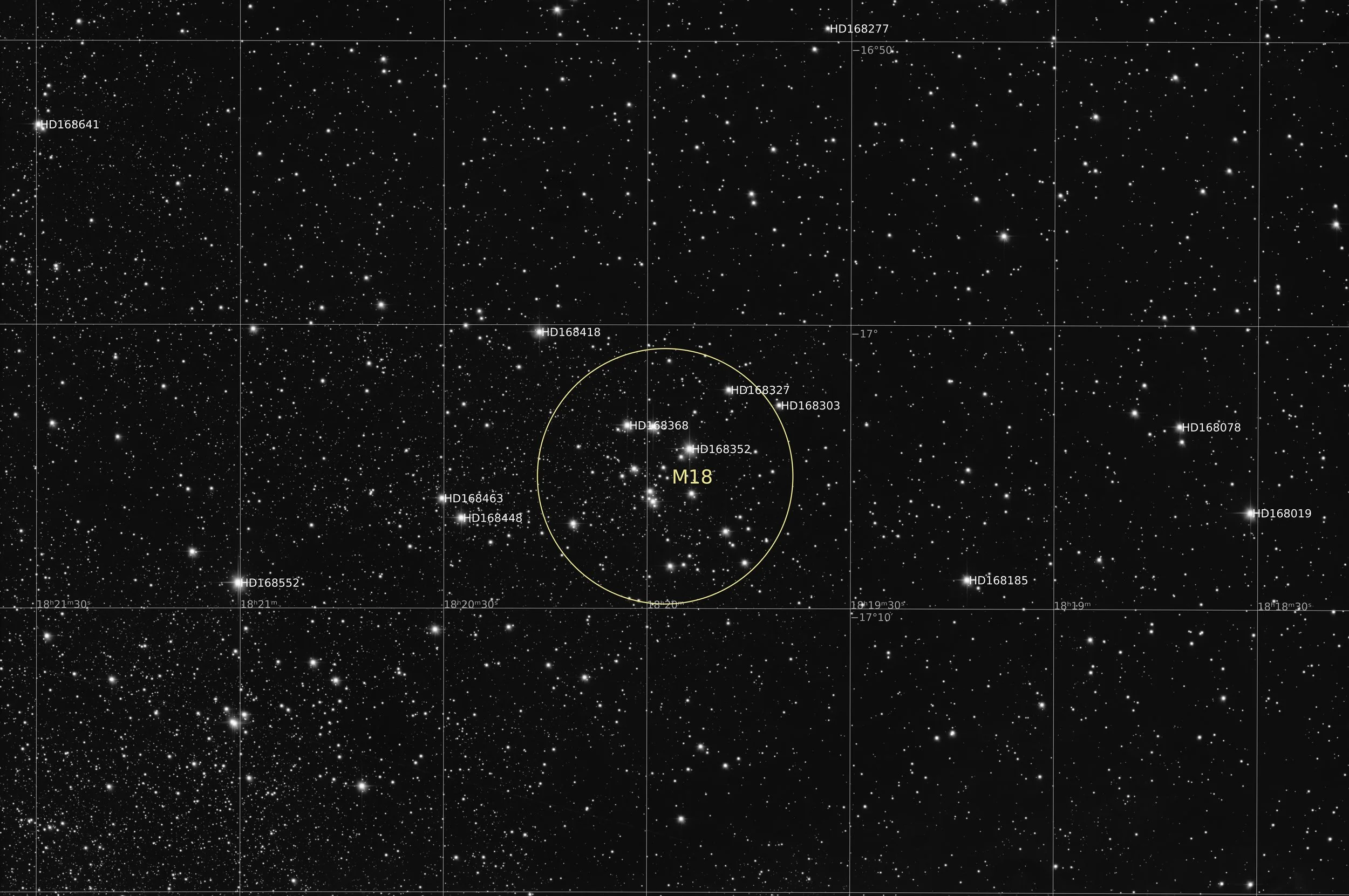M18
NGC 6613, Black Swan
47’ x 31’ | 0.3”/px | 9457 × 6283 px | full resolution
Sagittarius
RA 18h 19m Dec -17° 04’ | 0°



Messier 18, also designated NGC 6613 and sometimes known as the Black Swan Cluster, is an open cluster of stars in the constellation Sagittarius. It was discovered by Charles Messier in 1764. From the perspective of Earth, M18 is situated between the Omega Nebula (M17) and the Small Sagittarius Star Cloud (M24). This is a sparse cluster with a linear diameter of 26 lightyears, a tidal radius of 24 lightyears and is centrally concentrated with core radius of 0.04 lightyears. It has a Trumpler class of II 3 p. This means ‘Detached clusters with no noticeable concentration’ (II), ‘Cluster is composed of bright and faint stars’ (3) and ‘less than 50 stars’ (poor - p). The cluster is 33 million years old with an estimated mass of 188 sun masses. Messier 18 is 4200 lightyears from the Earth and 22.200 lightyears from the Galactic Center. It is orbiting the Milky Way core with a period of 186.5 million years and an eccentricity of 0.02. It passes vertically through the galactic plane once every 27.4 million years, ranging no more than 260 lightyears above or below.
source: Wikipedia
Data Acquisition
Data was collected over 4 nights in August 2025, mostly under full moon conditions, using a 14” reflector telescope with full-frame camera at the remote observatory in Spain. Data was gathered using standard RGB filters. A total of approximately 7 hours of data was finally combined to create the final image.
Location Remote hosting facility IC Astronomy in Oria, Spain (37°N 2°W)
Sessions
Frames
Equipment
Telescope
Mount
Camera
Filters
Guiding
Accessoires
Software
Planewave CDK14 (2563mm @ f/7.2), Optec Gemini Rotating focuser
10Micron GM2000HPS, custom pier
Moravian C3-61000 Pro (full frame), cooled to -10 ºC
Chroma 2” RGB unmounted, Moravian filterwheel L, 7-position
Unguided
Compulab Tensor I-22, Dragonfly, Pegasus Ultimate Powerbox v2
Voyager Advanced, Viking, Mountwizzard4, Astroplanner, PixInsight 1.9.3
Processing
All processing was done in Pixsinsight unless stated otherwise. Default features were enhanced using scripts and tools from RC-Astro, SetiAstro, GraXpert, CosmicPhotons and others. Images were calibrated using 50 Darks, 50 Flats, and 50 Flat-Darks, registered and integrated using WeightedBatchPreProcessing (WBPP). The processing workflow diagram below outlines the steps taken to create the final image.
No luminance data was collected. M18 is a straightforward object with no particular faint structures and the images were taken under (near) full moon conditions. This means that luminance does not add too much to the final details of the image, so the focus was to just record RGB.
In the green channel there was a hint left of a satellite trail that had not been properly removed by the rejection algorithm. Originally the thought was that it was faint enough to not show up in the final image, but unfortunately it did. The SetiAstro Blemish master tool did not work well to remove it. It simple cut stars in half. So the image was exported and the Inpainting Brush tool in Affinity Photo was used to carefully remove this trail.
The rest of the processing workflow followed standard procedures.
Processing workflow (click to enlarge)
This image has been published on Astrobin.
